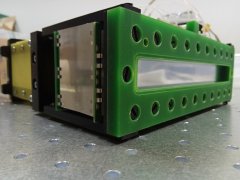For 2020, it is planned to continue work aimed at characterizing hydrogen isotope retention, with the emphasis being shifted to analyzing samples from experimental devices with magnetic plasma confinement, such as the ASDEX Upgrade tokamak and the Wendelstein 7X stellator.
As in previous years, tests on the same samples will be carried out in different centers (IFPiLM and ENEA (Italy), FZJ (Germany), CU (Slovakia), Differ (Netherlands), ISSP-UL (Latvia), UT (Estonia) and VTT (Finland)).
Considering the different mechanisms of the formation of layers inside the experimental plasma reactors, and diverse sample substrates, it should be expected that the main research tasks for 2020 will be: first, the adaptation of optimal measurement conditions, and, secondly, the determination of the ablation rate coefficient necessary for the quantitative determination of the amount of the ablated materials. The effect of sample temperature on the LIBS signal and the ablation coefficient will also be examined thanks to the use of fiber laser beam heating and temperature measurements using a thermocouple and / or pyrometer.
One should be aware that the first of these tasks (optimization) is significantly facilitated by the knowledge obtained in previous years, however the second (determination of the ablation coefficient) requires repeated exposures of samples with pulses of optimal parameters, and then conducting a time-consuming profilometric analysis. Nevertheless, this task is very important from the point of view of further work that will be used to adapt the method to the conditions in new generation reactors (such as ITER and DEMO). They are also important from the point of view of the continuation of works that were carried out under the MST2 project and are to be undertaken in 2021, when it is planned to install the remote-controlled LIBS head in the JET or WEST tokamak. Due to the much larger scale of these systems than the FTU tokamak on which MST2 was implemented, it will certainly be a big challenge, but its achievement will be a big step on the road to creating diagnostics of fuel retention and the chemical composition of the main wall key for fusion technology.
An additional research goal in 2020 is to test an alternative, cheaper solution for conducting LIBS measurements in the form of a compact spectrometer with lower resolution, but greater reliability and a much lower price than the currently used instrument equipped with ICCD. Tests with both devices will be carried out in parallel to check how much information obtained with a low resolution spectrometer can be recovered based on the data collected by the compact spectrometer.
The last of the research intentions for 2020 will be an attempt to use machine learning to analyze data obtained in experiments. Standard and publicly available machine learning libraries in Python such as PyTorch, TensorFlow, Scikit-learn, etc. will be used to implement it.










